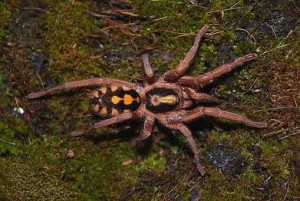Venezuelan Suntiger Tarantula (Psalmopoeus irminia)
New World, Psalmopoeus No Comments »This New World (NW) species comes from Venezuela though recently they have been found all the way in Brazil as well. The Venezuelan Suntiger tarantula is an arboreal species that is a crowd favorite due to its vibrant black coloring with orange chevron marks on its legs and an orange tiger-stripe design on their abdomen. This tarantula experience sexual dimorphism where females are usually bigger and more of a velvet black and sharp orange coloring while males are smaller and are a bit more faded/lighter in color. This is an average size tarantula that at full growth will end up being about 6 inches in size.
Habitat: Because they are tree dwelling spiders your enclosure should be taller with not so much floor space. As spiderlings you can keep them in a small vial with a twig or stick for them to climb up on. At full growth we recommend the most you needing being an 8″ x 8″ wide enclosure that is about 14″ tall. As they like to climb you should also add a decent sized vertical piece of bark with a water dish glued somewhere about 3″ to 4″ from the top. Place the cork bark in about 3″ of substrate. We recommend using coconut fiber such as eco-earth for its high resistance to mold. The Venezuelan Suntiger strives on temperatures of 70 to 90 degrees Fahrenheit with at least 70% humidity. They tend to web up and create thick tube webs in their enclosure and might even end up living somewhere at the base of their bark.
Feeding: As slings we recommend small pinhead crickets with their heads crushed off. As most tarantulas the Venezuelan Suntiger can live off of a steady diet of crickets, roaches, locusts, moths and worms. They are great eaters and are fast to pounce on their prey. Be cautious when opening their enclosure to feed them.
Attitude: Though a New World species, this tarantula does not have any urticating hairs. It is extremely defensive and relies solely on its speed and bite when threatened. We do not recommend this tarantula to inexperienced keepers. We also advise you to not handle a Suntiger tarantula because of these reasons.



